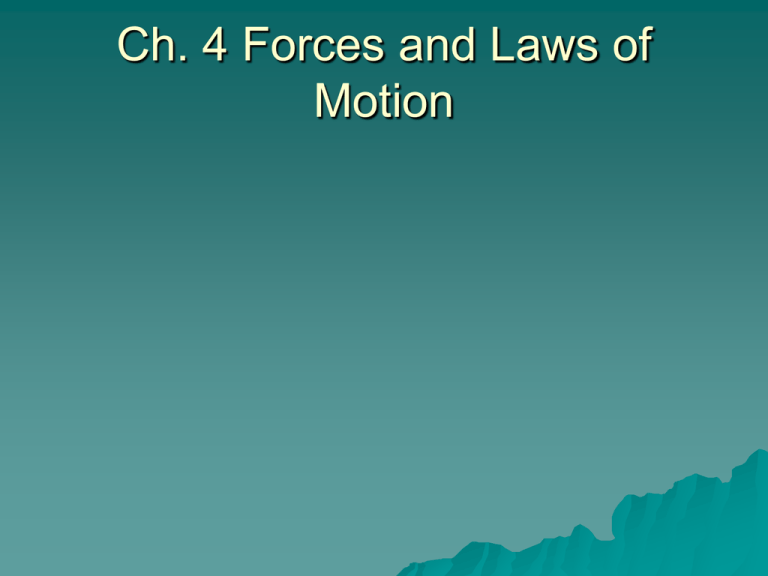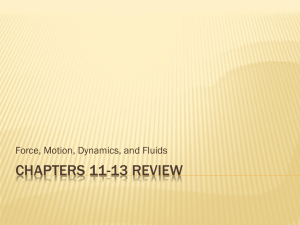4-4 Everyday Forces
advertisement

Ch. 4 Forces and Laws of Motion 4-1 Changes in Motion Key Terms pg. 150 Force-push or pull Force causes change in velocity (acceleration) SI unit of force is Newton (N) Weight is a measure of gravitational force on an object Contact forces-physical contact of two objects Ex: pull a string pull a wagon catch a football Field Forces-force between two objects without physical contact Ex: gravity electrical charges Force Diagrams Magnitude and direction of force affects an object’s motion Force is a vector Force diagrams show forces acting in a situation Free-body diagrams show only forces acting on an object Force Diagram Figure 4-4 pg. 127 4-1 Section Review Questions 4-2 Newton’s First Law An object at rest remains at rest, and an object in motion continues in motion with constant velocity(that is, constant speed in a straight line) unless the object experiences a net external force. Began by Galileo in 1630s, then further developed by Newton in 1687. Inertia- the tendency of an object not to accelerate When the net external force on an object is zero, its acceleration (or change in its velocity) is zero. Acceleration is determined by net external force Net external force is the vector sum of all the forces acting on an object. An object’s acceleration is the same as the net external force. Mass is a measurement of inertia Ex: basketball vs golf ball Golf ball will have larger acceleration due to less inertia Objects in motion tend to stay in motion Ex: crash test dummy/seat belt Fig. 4-14 Equilibrium Objects at rest or moving with constant velocity are at equilibrium The net external force acting on a body in equilibrium must be equal to zero. Resolve all vectors into their x and y components. When all the x vectors equal 0 and all the y vectors equal 0, then the vector sum is zero and the body is in equilibrium. Sample Problem 4A in book pg. 132 Another Sample Problem 4A:Sample Problem 4A.docx You have to find the net Force (hypotenuse force) and angle. 4-3 Newton’s 2nd and 3rd Laws Acceleration of an object is directly proportional to the net external force acting on it. Less force is needed to accelerate a low mass object than a high mass object at the same rate. In other words… A low mass object accelerates faster than a heavy object if the same force is applied. Newton’s Second Law The acceleration of an object is directly proportional to the net external force acting on the object and inversely proportional to the object’s mass. ∑F = ma Sample 4B Sample Problem 4B-Newton’s 2nd Law Fnet = ΣF = ma Roberto and Laura are studying across from each other at a wide table. Laura slides a 2.2 kg book toward Roberto. If the net external force acting on the book is 2.6 N to the right, what is the book’s acceleration? 4-3 continued… Forces Ex: always exist in pairs kicking a ball-the ball exerts a force on you and you exert a force on the ball Newton’s 3rd Law If two objects interact, the magnitude of the force exerted on object 1 by object 2 is equal to the magnitude of the force simultaneously exerted on object 2 by object 1, and these two forces are opposite in direction. For every action, there is an equal and opposite reaction. Action-reaction pair-describe the forces between 2 objects at the same time Action-reaction pairs do not result in equilibrium fig. 4-18 Field forces also exist in actionreaction pairs Ex: the force of Earth (gravity) on a person and the force of a person on Earth 4-4 Everyday Forces Fg = Force of gravity is a vector quantity toward the center of Earth Weight = a scalar quantity, the magnitude of Force of gravity Fg = mg Weight depends on location (g) Objects weigh less at higher altitudes because g decreases Normal Force Normal Force = Fn The force perpendicular to the surface of contact Not always opposite of gravity In the absence of other forces, the normal force is equal and opposite to the force of gravity that is perpendicular to the contact surface Fn = mg(cosθ) The angle is the angle between the normal force and a vertical line and also the angle between the contact surface and a horizontal line. See fig. 4-20 Force of Friction Friction opposes the applied force The resistive force that keeps an object from moving is the static friction (Fs) Fs = -Fapplied as long as the object does not move Fs, max = when the force is as great as it can be without moving the object. Kinetic Friction Fapplied > Fs, max =the object moves but there is still friction Fk (kinetic friction) = the retarding force on an object in motion The net external force is equal to the difference between applied force and kinetic friction force (Fnet = Fapplied – Fk) Friction arises from interactions at microscopic levels The force required to move a stationary object is greater than the force to keep an object moving. Fs, max > Fk Magnitude of the force of friction is proportional to the normal force exerted on an object by a surface (weight). The force of friction depends on the composition and quality of the surfaces in contact. Ex: carpet vs. tile μk = Fk Fn μs = Fs, max Fn Ff = μFn Coefficient of kinetic friction is always less than or equal to the coefficient of static friction Air resistance is a form of friction Air resistance = FR When air resistance equals Fg (gravity), an object has terminal speed. Sample Problem 4C-Coefficients of friction A 24 kg crate initially at rest on a horizontal floor requires a 75 N horizontal force to set it in motion. Find the coefficient of static friction between the crate and the floor. μs = Fs, max = Fs, max Fn mg




